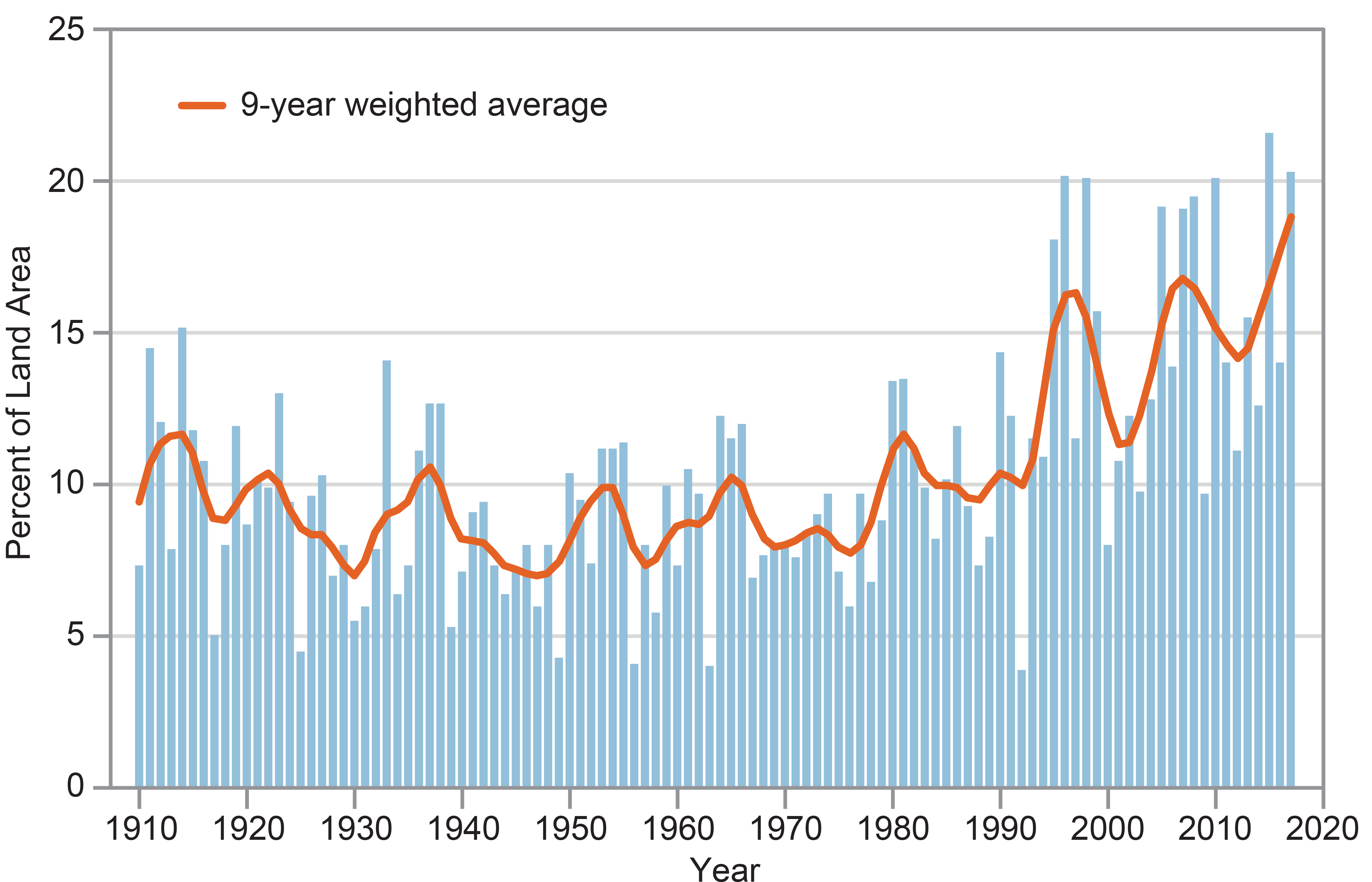Each regional author team organized a stakeholder engagement process to identify the highest-priority concerns, including priorities for agriculture and rural communities. Due to the heterogeneous nature of agriculture and rural communities, the national chapter leads (NCLs) and coauthor team put in place a structured process to gather and synthesize input from the regional stakeholder meetings. Where possible, one or more of the authors or the chapter lead author listened to stakeholder input during regional stakeholder listening sessions. Information about agriculture and rural communities was synthesized from the written reports from each regional engagement workshop. During the all-authors meeting on April 2–3, 2017, the NCL met with authors from each region and other national author teams to identify issues relevant to this chapter. To finalize our regional roll-up, a teleconference was scheduled with each regional author team to discuss agriculture and rural community issues. Most of the regional author teams identified issues related to agricultural productivity, with underlying topics dominated by drought, temperature, and changing seasonality. Grassland wildfire was identified as a concern in the Northern and Southern Great Plains. All regional author teams identified soil and water vulnerabilities as concerns, particularly as they relate to soil and water quality impacts and a depleting water supply, as well as reduced field operation days due to wet soils and an increased risk of soil erosion due to precipitation on frozen soil. Heat stress in rural communities and among agricultural workers was of concern in the Southeast, Southern Great Plains, Northwest, Hawaiʻi and Pacific Islands, U.S. Caribbean, and Northeast. Livestock health was identified as a concern in the Northeast, Midwest, U.S. Caribbean, and Southern Great Plains. Additional health-related concerns were smoke from wildfire, pesticide impacts, allergens, changing disease vectors, and mental health issues related to disasters and climate change. Issues related to the vulnerability and adaptive capacity of rural communities were identified by all regions. Discussions with the regional teams were followed by expert deliberation on the draft Key Messages by the authors and targeted consultation with additional experts. Information was then synthesized into Key Messages, which were refined based on published literature and professional judgment.
Key Message 1: Reduced Agricultural Productivity
Food and forage production will decline in regions experiencing increased frequency and duration of drought (high confidence). Shifting precipitation patterns, when associated with high temperatures, will intensify wildfires that reduce forage on rangelands, accelerate the depletion of water supplies for irrigation, and expand the distribution and incidence of pests and diseases for crops and livestock (very likely, high confidence). Modern breeding approaches and the use of novel genes from crop wild relatives are being employed to develop higher-yielding, stress-tolerant crops.
Description of evidence base
The Key Message and supporting text summarize extensive evidence documented in the U.S. Global Change Research Program’s (USGCRP) Climate Science Special Report84 indicating increasing drought frequency or severity in many parts of the United States, increased temperature, and increased frost-free days. An increased probability of hot days concurrent with drought has been reported by Mueller and Seneviratne (2012),235 Mazdiyasni and AghaKouchak (2015),236 and Diffenbaugh et al. (2015).107 The warming of minimum temperatures (lack of hard freezes) is contributing to expanding ranges for many insect, disease, and weed species.237 Bebber et al. (2013)238 report an average poleward shift of 2.7 km/year (1.68 miles/year) since 1960 of numerous pests and pathogens.
Agricultural production: Walthall et al. (2012)38 synthesize a wide body of literature that documents the impacts of climate, including drought, on crop and livestock productivity and on the natural resources that support agricultural production. Marshall et al. 201597 also quantified climate change impacts on the yield of major U.S. crops as well as the reduced ability in the future to mitigate drought by irrigation. Havstad et al. (2016)239 describe the resilience of livestock production on rangelands in the Southwest and identify adaptation management strategies needed in an increasingly arid and variable climatic environment. Liang et al. (2017)240 found that total factor productivity (TFP) for the U.S. agriculture sector is related to regional and seasonal temperature and precipitation factors. Rosenzweig et al. (2014)241 indicated strong negative effects of climate change on crop yields, particularly at higher levels of warming and lower latitudes. While technological improvements have outweighed the aggregate negative impacts of climate to date, projected climate change indicates that U.S. agriculture TFP could drop to pre-1980s levels by 2050. Ray et al. (2015)242 estimate that climate accounts for about one-third of global yield variability.
Crop heat stress: Novick et al. (2016)243 indicate that atmospheric vapor pressure deficits play a critical role in plant function and productivity and that it will become more important at higher temperatures as an independent factor, relative to available soil moisture. For instance, high temperature has been documented to decrease yields of major crops, including wheat, corn, rice, and soybean.92,113,120,244 Multimodel simulations indicated that grain yield reductions of wheat at high temperature were associated with reduced grain number per head120 and that yield reductions were increased with higher temperature increases across a wide range of latitudes.241 Hatfield et al. (2017)245 report that yield gaps for Midwest corn were negatively related to July maximum and August minimum temperatures but positively related to July–August rainfall, and that soybeans were less sensitive to projected temperature changes than corn. For corn, projected yield gaps showed a strong North–South gradient, with large gaps in southern portions of the region. Kukal and Irmak (2018)246 reported that changes in the variability of maize, sorghum, and soybean yield patterns in the Great Plains from 1968–2013 were linked to temperature and precipitation, with irrigated crops showing low variability compared to rainfed crops. Temperature increases were detrimental to sorghum and soybean yield but not to corn during this period. Tebaldi and Lobbell (2015)247 projected that corn would benefit from greenhouse gas mitigation to limit temperature increases throughout this century. For wheat, but less so for corn, impacts of exposure to extremely high temperatures would be partially offset by carbon dioxide fertilization effects. Tack et al. (2015)248 report that the largest drivers of Kansas wheat yield loss over 1985–2013 were freezing temperatures in the fall and extreme heat events in the spring.249,250 The overall effect of warming on yields was negative, even after accounting for the benefits of reduced exposure to freezing temperatures. Warming effects were partially offset by increased spring precipitation. Of concern was evidence that recently released wheat varieties are less able to resist high temperature stress than older varieties. Gammans et al. (2017)251 found that wheat and barley yields in France were negatively related to spring and summer temperatures. Liu et al. (2016)252 report that with a 1.8°F (1°C) global temperature increase, global wheat yield is projected to decline between 4.1% and 6.4%, with the greatest losses in warmer wheat-producing regions. Wienhold et al.(2017)253 identify an increase in the number of extreme temperature events (higher daytime highs or nighttime lows) as a vulnerability of Northern Great Plains crops due to increased plant stress during critical pollination and grain fill periods. Burke and Emerick (2016)254 found that adaptation appeared to have mitigated less than half of the negative impacts of extreme heat on productivity.
Wildfire and rangelands: Margolis et al. (2017)255 report that fire scars in tree rings for the years 1599–1899 indicate that large grassland fires in New Mexico are strongly influenced by the current year cool-season moisture, but that fires burning mid-summer to fall are also influenced by monsoon moisture. Wet conditions several years prior to the fire year, resulting in increased fuel load, are also important for spring through late-summer fires. Persistent cool-season drought lasting longer than three years may inhibit fires due to the lack of moisture to replenish surface fuels. Donovan et al. (2017)95 reported that wildfires greater than 400 hectares increased from 33.4 ± 5.6 per year during the period 1985–1994 to 116.8 ± 28.8 wildfires per year for the period 2005–2014 and that the total area burned in the Great Plains by large wildfires increased 400%.
Water supply: Dai and Zhao (2017)256 quantify historical trends in drought based on indices derived from the self-calibrated Palmer Drought Severity Index and the Penman–Monteith potential evapotranspiration index. For greater reliability, they compare these results with observed precipitation change patterns, streamflow, and runoff in three different periods: 1950–2012, 1955–2000, and 1980–2012. They indicate that spatially consistent patterns of drying have occurred in many parts of the Americas, that evaporation trends were slightly negative or slightly positive (exclusive of 1950–1980), and that drought has been increasingly linked to increased vapor pressure deficits since the 1980s.
Pest pressures: Integrated pest management is rapidly evolving in the face of intensifying pest challenges to crop production.257 There is considerable capacity for genetic improvement in agricultural crops and livestock breeds, but the ultimate ability to breed increased heat and drought tolerance into germplasm while retaining desired agronomic or horticultural attributes remains uncertain.258 The ability to breed pest-resistant varieties into a wide range of species to address rapidly evolving disease, insect, and weed species237 is also uncertain.
Major uncertainties
Drought impacts on crop yields and forage are critical at the farm economic scale and are well documented.38,97 However, the extent to which drought impacts larger-scale issues of food security depends on a wide range of economic and social factors that are less certain. Chavez et al. (2015)259 lay out a framework for food security assessment that incorporates risk mitigation, risk forecast, and risk transfer instruments. There is considerable uncertainty in what is expected for the frequency and severity of future droughts.260 However, retrospective analyses and global climate modeling of 1900–2014 drought indicators show consistent results. The applied global climate models project 50%–200% increases in agricultural drought frequency in this century, even under low forcing scenarios. There is uncertainty about the interactive effects of carbon dioxide concentration, temperature, and water availability on plant physiological responses, particularly in highly dynamic field environments. There is uncertainty about future technological advances in agriculture and about changes in diet choices and food systems.
Description of confidence and likelihood
The USGCRP84 determined that recent droughts and associated heat waves have reached record intensities in some regions of the United States; however, by geographic scale and duration, the 1930s Dust Bowl remains the benchmark drought and extreme heat event in the historical record since 1895 (very high confidence). The confidence is high that drought negatively impacts crop yield and quality, increases the risk of range wildfires, and accelerates the depletion of water supplies (very likely and high confidence).
Key Message 2: Degradation of Soil and Water Resources
The degradation of critical soil and water resources will expand as extreme precipitation events increase across our agricultural landscape (high confidence). Sustainable crop production is threatened by excessive runoff, leaching, and flooding, which results in soil erosion, degraded water quality in lakes and streams, and damage to rural community infrastructure (very likely, very high confidence,). Management practices to restore soil structure and the hydrologic function of landscapes are essential for improving resilience to these challenges.
Description of evidence base
Evidence of long-term changes in precipitation is based on analyses of daily precipitation observations from the National Weather Service’s Cooperative Observer Network.261
Groisman et al. (2012)262 reported that for the central United States, the frequency of very heavy precipitation increased by 20% from 1979–2009 compared to 1948–1978. Slater and Villarini (2016)263 report a significant increase in flooding frequency in the Southern Plains, California, and northern Minnesota; a smaller increase in the Southeast; and a decrease in the Northern Plains and Northwest. Mallakpour and Villarini (2015)264 report an increasing frequency of flooding in the Midwest, primarily in summer, but find limited evidence of a change in magnitude of flood peaks.
Infrastructure: Severe local storms constituted the largest class of billion-dollar natural disasters from 1980 to 2011, followed by tropical cyclones and nontropical floods.265 Špitalar et al. (2014)266 evaluate flash floods from 2006 to 2012 and find that the floods with the highest human impacts, based on injuries and fatalities, are associated with small catchment areas in rural areas. Rural areas face particular challenges with road networks and connectivity.267
Soil and water: Soil carbon on agricultural lands is decreased due to land-use change and tillage,268,269 resulting in decreased hydrologic function.101 Practices that increase soil carbon have an adaptation benefit through improved soil structure and infiltration, improved water-holding capacity, and improved nutrient cycling. There are many practices that can enhance agricultural resilience through increased soil carbon sequestration.75,268,270,271,272,273 Houghton et al. (2017)274 identify the health effects associated with poor water quality that can be associated with nutrient transport to water bodies and subsequent eutrophication.
Major uncertainties
Floods are highly variable in space and time,86 and their characteristics are influenced by a number of non-climate factors.275 Groissman et al. (2012)262 note that the lack of sub-daily data to analyze precipitation intensity means that daily data are normally used, which limits the ability to detect the most intense precipitation rates. While many practices are available to protect soil and reduce nutrient runoff from agricultural lands,268,272 adoption rates by producers are uncertain. Additionally, there is uncertainty about the extent to which agribusiness will invest in soil improvement to mitigate risks associated with a changing climate and its effects on water, energy, and plant and animal supply chains.276
Description of confidence and likelihood
The evidence on increasing precipitation intensity, with the largest increases occurring in the Northeast, is high (very likely, high confidence). The increase in flooding is less certain (likely, medium confidence). The evidence of the impact of precipitation extremes on infrastructure losses, soil erosion, and contaminant transport to water bodies is well established (very likely, high confidence). Based on medium confidence on flooding but high confidence in increasing precipitation intensity and the impacts of precipitation extremes, there is high confidence in this Key Message.
Key Message 3: Health Challenges to Rural Populations and Livestock
Challenges to human and livestock health are growing due to the increased frequency and intensity of high temperature extremes (very likely, high confidence). Extreme heat conditions contribute to heat exhaustion, heatstroke, and heart attacks in humans (very likely, high confidence). Heat stress in livestock results in large economic losses for producers (very likely, high confidence). Expanded health services in rural areas, heat-tolerant livestock, and improved design of confined animal housing are all important advances to minimize these challenges.
Description of evidence base
The Key Message and supporting text summarize extensive evidence documented in the USGCRP’s Climate Science Special Report.84
Humans: Houghton et al. (2017)274 synthesize the literature that presents strong evidence of climate change impacts on human health in rural areas. Anderson et al. (2018)277 find that heat waves pose risks to human mortality but that the risk associated with any single heat wave depends on many factors, including heat wave length, timing, and intensity. On average, heat waves increase daily mortality risk by approximately 4% in the United States,278 but extreme heat waves present significantly higher risks. While research on heat-related morbidity has focused on urban areas, Jagai et al. (2017)279 analyzed heat waves in Illinois over 1987–2014 and found that there were 1.16 hospitalizations per 100,000 people in the most rural, thinly populated areas, compared to 0.45 hospitalizations per 100,000 in metropolitan areas. Consequently, a 1.8°F (1°C) increase in maximum monthly temperature was associated with a 0.34 increase in hospitalization rates in rural areas compared to an increase of 0.02 per 100,000 in urbanized counties. The mean cost per hospital stay was $20,050. Fechter-Leggett et al. (2016),280 Hess et al. (2014),281 and Sugg et al. (2016)282 also report an elevated risk in rural areas for emergency room visits for heat stress. Additionally, rural areas have a high proportion of outdoor workers who are at additional risk for heat stress.279,283,284 Merte (2017)285 analyzed data from 1960 to 2015 for 27 European countries and found that 0.61% of all deaths were caused by extreme heat.
Major uncertainties
Humans: Much of the literature focuses on heat-related mortality in urban areas (e.g., Oleson et al. 2015; Marsha et al. 2017286,287). Vulnerability and exposure in rural areas are not well understood, but Oleson et al. (2015),286 in quantifying projected future temperature impacts, indicate that urban areas will experience more summer heat days and reduced winter cold temperature days than rural areas. Huber et al. (2017)288 identify uncertainties in estimated impacts of death from cardiovascular diseases from a 1.8°F (1°C) increase in global temperature. Anderson et al. (2018)277 discuss uncertainties associated with changes in the size and age of the population and the breadth of plausible socioeconomic scenarios. Jones et al. (2015)289 identify uncertainties in the migration of population due to a changing climate and how that would impact exposure. Hallstrom et al. (2017)290 evaluated the possible effects of future diet choices on various health indicators, many of which would have impacts on an individual’s sensitivity to high temperature.
Livestock: Walthall et al. (2012)38 synthesize a wide body of literature that documents the impacts of extreme temperature effects on livestock health and productivity. Ruminant livestock support rural livelihoods and produce high-quality food products from land that is otherwise unsuited to crop agriculture.291,292
Description of confidence and likelihood
Extreme temperatures are projected to increase even more than average temperatures. The temperatures of extremely cold days and extremely warm days are both projected to increase. Cold waves are projected to become less intense, while heat waves will become more intense (very likely, very high confidence).293
Lehner et al. (2017)294 indicate a high likelihood and high confidence that there will be increased record-breaking summer temperatures by the end of the century. Evidence of challenges to human and livestock health due to temperature extremes is well established (very likely, very high confidence).
Key Message 4: Vulnerability and Adaptive Capacity of Rural Communities
Residents in rural communities often have limited capacity to respond to climate change impacts, due to poverty and limitations in community resources (very likely, high confidence). Communication, transportation, water, and sanitary infrastructure are vulnerable to disruption from climate stressors (very likely, high confidence). Achieving social resilience to these challenges would require increases in local capacity to make adaptive improvements in shared community resources.
Description of evidence base
A wealth of data shows that residents of rural areas generally have lower levels of education and lower wages for a given level of education compared to residents of urban areas.295 Higher levels of poverty, particularly childhood poverty,7 and food insecurity in rural compared to urban areas are also well documented.49 There is also research that documents the disproportionate impacts of climate change on areas with multiple socioeconomic disadvantages, such as an increased risk of exposure to extreme heat and poor air quality, lack of access to basic necessities, and fewer job opportunities.229
Major uncertainties
There is uncertainty about future economic activity and employment in rural U.S. communities. However, the patterns of lower education levels, higher poverty levels, and high unemployment have been persistent and are likely to require long-term, focused efforts to reverse.6,49,295 There are numerous federal programs (such as the USDA’s regional Climate Hubs, the National Oceanic and Atmospheric Administration’s Regional Integrated Sciences and Assessments program, and the U.S. Department of the Interior’s Climate Adaptation Science Centers) that focus on outreach and capacity building to rural and underserved communities. Additionally, the Cooperative Extension Service and state agencies, as well as various nongovernmental organizations, provide support and services to build the adaptive capacity of individuals and communities.
Description of confidence and likelihood
Lower levels of education, poverty, limited infrastructure, and lack of access to resources will limit the adaptive capacity of individuals and communities (very likely, high confidence). Adaptive capacity in rural communities is being increased through federal, state, and local capacity building efforts (likely, low to medium confidence). However, the outreach to rural communities varies greatly in different parts of the United States.







